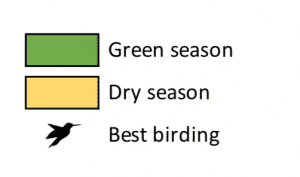- When is the best time of year for a Tanzania safari?
- When is the wildebeest migration?
- What are the different types of safari accommodations?
- What are the tipping customs on safari?
There is never a bad time to go on safari in Tanzania.
In northern Tanzania, the dry seasons generally last from mid-June through October and January through mid-March. During the dry seasons brush and grasses are low and animals tend to congregate around permanent watercourses – for easier spotting. These are the high seasons for game viewing in Tanzania, and the number of tourists and prices reflect that.
During the light rains of November to December and long rains from late March through early June the savanna bursts into green, previously dry rivers flow, and wildlife disperse. These “green seasons” find fewer tourists, lower prices, and a landscape that seems more alive, yet still plenty of wildlife sightings under the expertise of SENE guides.
Bird-watching in Tanzania is spectacular any time of year. As with animals, visibility increase with the dry season, but Tanzania also has many migratory bird species that are resident during the northern hemisphere winter.
Below is a general guide to seasonal climate patterns in Tanzania safari parks. The information comes from weather data and our own experience, not a crystal ball! Please understand that weather patterns across Tanzania are becoming increasingly unpredictable as the global climate changes.

